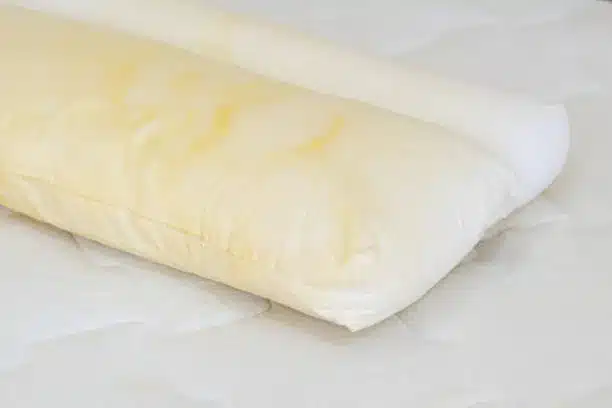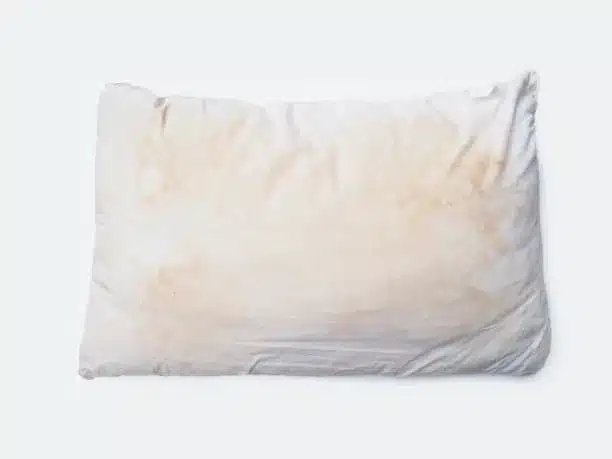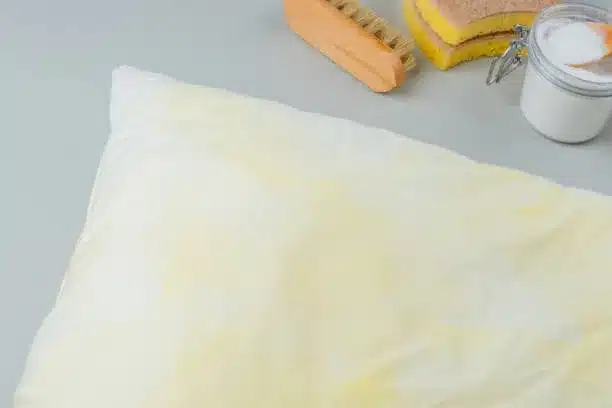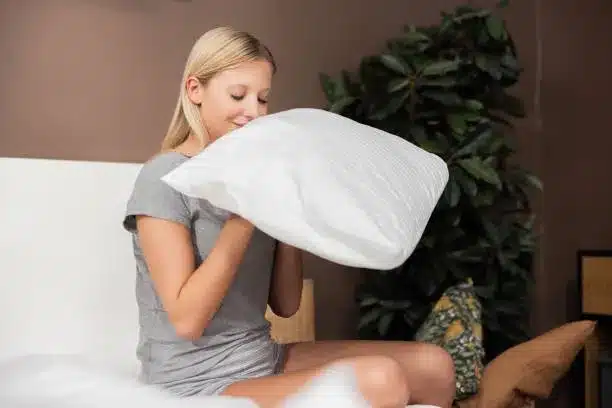
Why Do Pillows Go Yellow: Pillows turning yellow can be frustrating, but it’s a common issue that happens over time due to sweat, moisture, and natural oils from your body. These factors accumulate on the pillow’s surface, causing discoloration and creating yellow stains. The process can be due to a variety of reasons, including drool, wet hair, and even skincare products like lotions and oils. Bacteria and allergens can also contribute to the yellowing as they harbor in the moist substances left behind on the pillow. As these stains develop, they often turn into unsightly marks, which are difficult to ignore.
The quality of your pillow can affect how much it absorbs these substances, but over time, this accumulation is inevitable. Whether you’re aware of it or not, you may notice the yellowing after certain periods, as moisture and oils seep into the pillow’s exterior. Aging is another factor, as pillows naturally deteriorate over time. While this doesn’t indicate a hygiene crisis, it’s essential to understand the causes of the problem and take action to remove these stains with proper care. Regular cleaning can help, but if the pillow is too far gone, it may be time to replace it entirely.
Why Pillows Turn Yellow

Pillows can turn yellow due to bodily moisture that accumulates on your pillowcase. Sweating is a common source of this discoloration, but it’s not the only culprit. Different types of moisture, including saliva and oils from the skin, can seep through and cause stains. Although sweating is the most frequent cause, other factors like wet hair or even skincare products contribute as well. Over time, this moisture gets absorbed into the fabric, leading to yellow stains that can be challenging to remove. These stains are a natural result of how our bodies interact with the pillow during sleep, but with care and proper cleaning, you can manage and even prevent them.
The Role of Sweat in Yellowing Pillows
Excessive sweating at night can sometimes signal a more serious health condition, but in most cases, it’s a normal part of how the body regulates its temperature during sleep. While sweating helps cool the body, it can also cause yellow stains if it leaks through the pillowcase. This can be a common issue, especially if the pillow is exposed to moisture for long periods. However, there are certain things you can do to minimize this process. Sleeping in a cooler room or wearing lighter pajamas are effective strategies to mitigate night sweats and help keep your pillow from turning yellow. These simple adjustments can go a long way in reducing the impact of sweat on your pillow.
Wet Hair and Its Role in Pillow Discoloration
For individuals with long hair, going to bed with wet hair might feel unavoidable. However, this damp hair can have a similar effect as sweat, contributing to yellow stains on your pillow. When you shower at night, the water left in your hair can easily penetrate the pillowcase, causing moisture to accumulate. Over time, this moisture leads to stains and discoloration on your pillow.
To prevent this, it’s important to leave adequate time between showering and bedtime, allowing your hair to dry. This simple adjustment will help ensure that less moisture is left on your pillow, reducing the chances of yellowing and maintaining the quality of your pillow over the long term.
Drool and Pillow Discoloration
Drooling during sleep can occur for various reasons, such as allergies, acid reflux, or teeth grinding. Back sleepers are less prone to drooling compared to those who sleep on their stomach or side. This excess moisture can seep into your pillow, contributing to unsightly stains and discoloration. By addressing the causes of drooling, you can help limit the amount of moisture that comes into contact with your pillow.
Even a few adjustments, like sleeping in a different position or using a special pillowcase, can make a big difference. This can help reduce the likelihood of yellow stains and maintain the cleanliness of your pillow for a longer time.
Skin and Hair Oil Contribution to Pillow Yellowing
The sebaceous glands in your body are responsible for producing oil for both your skin and hair. This oil, known as sebum, plays a critical role in maintaining dermatological health. However, when these glands become overactive, they can produce excess oil, leaving an oily residue on your pillow. This buildup of skin and hair oil can easily absorb into your pillow, causing it to turn yellow over time.
This is one of the main reasons why pillows may develop stains as the oils lead to discoloration. It’s important to keep in mind that the oils from your skin and hair are often responsible for this yellowing process, which can happen gradually.
Lotions, Face Creams, and Beauty Products
Many people have a nightly skincare routine that involves applying lotions, creams, and other beauty products to their faces before bedtime. These products are meant to absorb into the skin, but if they don’t fully absorb before sleep, they can seep into your pillow. This can contribute to discoloration and stains over time. Even though these products are meant to improve skin health, their unabsorbed residues can lead to yellowing of your pillow. It’s essential to give these products adequate time to absorb or take extra care to prevent them from coming into contact with your pillow.
How to Remove Yellow Stains From Your Pillow

- Pillow protectors and quality pillowcases can help prevent yellow stains and discoloration from starting.
- To keep your pillow in top condition, read care instructions and follow guidelines based on its materials and construction.
- For machine-washable pillows, follow the instructions for washing; delicate pillows may need a dry cleaner or spot cleaning.
- Treat yellowed areas using a cleaning agent such as soap or another appropriate solution, wiping off after applying.
- If the stains persist, try soaking the pillow in bleach (only if safe), or use hydrogen peroxide solutions to target stained areas.
- Lemon juice and baking soda can create a paste that you apply to the stains, letting it sit for minutes before rinsing.
- You can use vinegar soaks by submerging your pillow in warm water and vinegar overnight and washing it with mild detergent.
- Enzyme cleaners and sprays that target organic stains can be effective in breaking down the residue causing the yellow stains.
- Sunlight exposure can help naturally freshen your pillow by removing stains and odors.
- Rotate your pillow occasionally while drying it in direct sunlight to ensure it is completely dry.
- Avoid harsh chemicals and overly rigorous cleaning methods that could damage the fabric.
How to Prevent Your Pillows From Turning Yellow

- Minimize moisture by taking steps to insulate your pillow and extend its lifespan.
- Use a pillow protector with a sealed fabric layer between your pillow and pillowcase to help discoloration and prevent yellowing.
- Choose higher-quality bed linens and pillowcases designed to keep moisture away and slow down the yellowing process.
- Protective casings are cost-effective and help manage oils and skin moisture, maintaining luxury firmness and ensuring pillows stay in better condition.
- Sleepers should buy pillowcases that suit their needs to prevent yellow stains and ensure the pillow stays in pristine condition for a long time.
- A popular option is a protective pillow casing, which can prevent your pillow from becoming unprotected and turning yellow while maintaining its overall quality.
Tips to Keep Pillows Clean and White
- Invest in pillow protectors to create an extra layer of defense against sweat and oils.
- Wash pillows regularly, every three to six months, to keep them clean and prevent yellowing.
- Sun drying is a great option for airing out pillows in direct sunlight. It helps to whiten fabrics and remove lingering odors.
- Pillows don’t last forever, so it’s important to replace them every 1-2 years to maintain a clean and supportive surface.
Why It’s Important to Keep Pillows Clean
Keeping pillows clean is crucial for their longevity and maintaining their quality over time. Regular care helps prolong the lifespan of your pillow by preventing it from degrading. Maintaining a clean sleep environment ensures a restful night by reducing distractions like allergens and odors. Clean pillows contribute to better sleep, which positively affects brain, heart, and immune system functions, improving alertness and mood. Proper maintenance of pillows is a simple yet essential step in supporting overall health and hygiene.
Conclusion
In conclusion, understanding why pillows turn yellow and how to prevent and remove stains is crucial for maintaining their quality and longevity. The accumulation of sweat, oils, moisture, and other substances over time can lead to discoloration, but you can manage and even prevent these issues with the right care and attention. Using pillow protectors, following proper cleaning methods, and making small adjustments to your sleeping habits can go a long way in keeping your pillow clean and in good condition. Regular maintenance not only extends the lifespan of your pillow but also ensures a healthier, more restful sleep environment.
FAQ’s
Yellowing generally occurs when sweat, oils, and dead skin cells from the body seep into the pillow’s fabric, causing oxidation and a color change as time passes.
Certain pillows might need specific treatment. Combine white vinegar and water equal parts, or create a paste using baking soda and water. Apply the mixture to the yellowed spots and leave it for 30 minutes to an hour. If machine washable, place the pillows in the washer, using a gentle cycle with warm water.
Cleaning professionals recommend a blend of baking soda, white vinegar, and laundry detergent to remove yellow stains. Baking soda works effectively to eliminate odors and brighten your pillow.
In some cases, replacing your pillow may be necessary for a better night’s sleep. If you frequently struggle with sinus problems, congestion, or other issues, your pillow could be the cause.


